4 devices that'll take the shakes out of your amateur videos
In the olden days, it was easy to tell the difference between amateur and professional video. Even if the composition was identical, pro video had obviously better picture and sound—and it was stable.
Over the years, the video and sound quality of phone cameras have dramatically improved. But in general, the stability of the picture is still a giveaway. Pros use tripods or Steadicam rigs; amateurs hold their phones in their jiggly, unsteady hands.
To help out, the tech industry has devised a whole raft of mobile stabilizing rigs to hold your phone or GoPro (GPRO), like these.
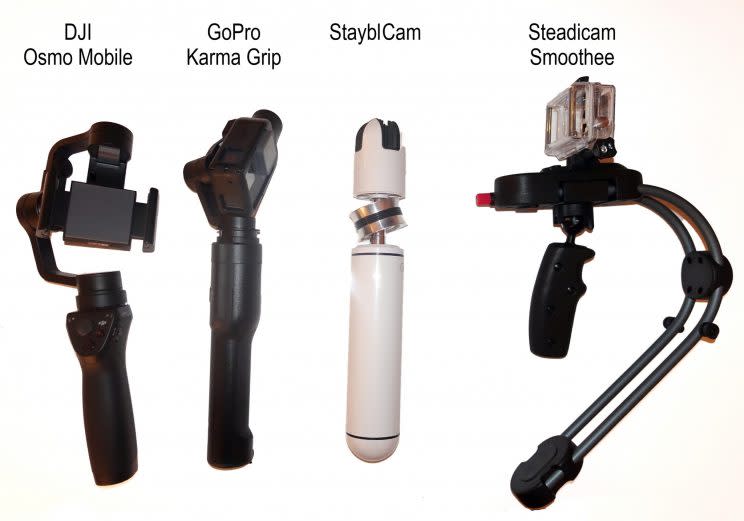
They’re not as good as an actual Steadicam, the expensive, professional, body-worn rig that lets you walk or even run while still allowing the camera to float, bump-free. (That shot of Rocky running up the Philadelphia art-museum steps was an early, famous Steadicam shot.)

But they’re infinitely better than trying to shoot with your hand, as my video above should make clear.
(A note about stabilized phones: Some high-end phones have built-in, optical stabilizers—the iPhone 6s Plus, 7, and 7 Plus, for example, and the Galaxy S6 and S7. They work at least as well as the inexpensive stabilizers described here, but not nearly as well as the motorized ones. Lots of people get truly amazing footage using a stabilized phone in one of these stabilizing products—but lots also report that the two stabilizers sometimes fight each other, resulting in an unpleasant “judder” [shudder/jitter] when you’re panning. The solution would be to turn off the phone’s built-in stabilization—but most phones offer no way to do that. You’ve been warned.)
There are, by the way, dozens of these stabilizers. I tested four of them in a range of designs and price tags. Here’s what I discovered.
StayblCam
Weirdest darned thing you ever have seen. The StayblCam ($75, a Kickstarter hit) is a 10-inch, white or black plastic capsule/stick thing. You wedge your phone into the rubber grippers. You pull the plastic capsule ends apart, revealing a metal extension pole In the center of it with a ring on a ball bearing.
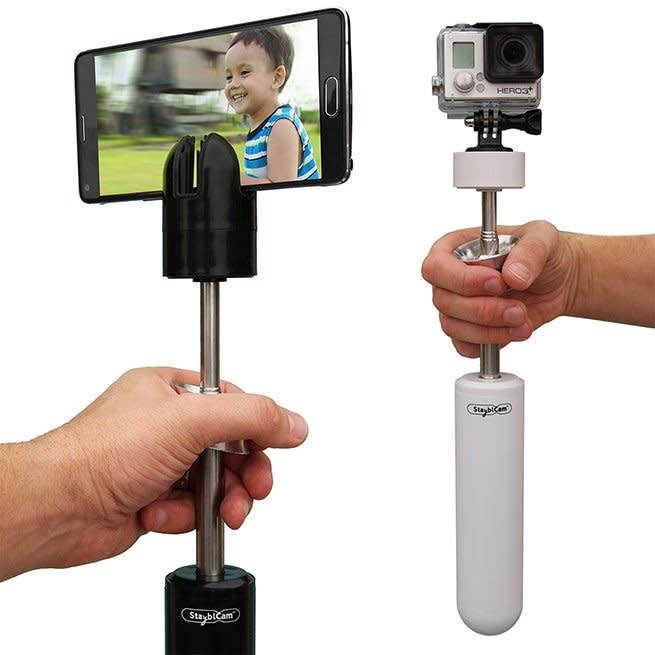
The central idea is that you’ll hold onto this ring, allowing the stick to swing freely like a pendulum.
To set this up, you must first fiddle with the ends of the StayblCam until it balances on that ring horizontally. Getting that right is fussy, and there’s no way to memorize the positions of the end chunks to make the setup faster the next time.
Once it’s perfectly balanced horizontally, you can turn the whole thing vertical. You wrap your thumb and index finger around the ring, and use your ring and pinky fingers on the pole itself, to prevent the whole thing from swinging as you walk. Even then, the swinging can be a problem, especially if it’s windy.
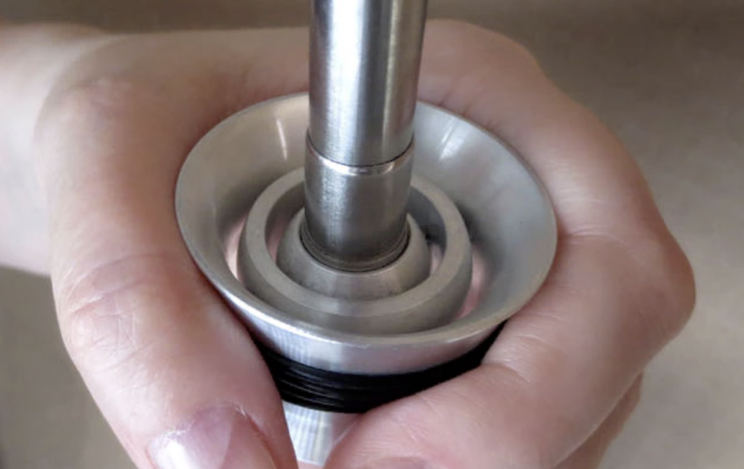
If you compare the footage, there’s no question: Your video is smoother with the StayblCam than without it.
But this is a polarizing pole; on Amazon (AMZN), people tend to give this thing either 5-star or 1-star ratings. It’s goofy, it’s clunky to set up, and it only kind of works.
On the other hand, it’s waterproof and rugged. It never needs charging. You can unscrew the phone holder and replace it with a threaded mount for a camera or GoPro. You can turn the whole thing upside-down, for smooth ground-level (or pet-level, or baby-level) video that’d be hard to shoot otherwise. And poles telescope out quite a bit—enough for the phone to sit 3 feet above your hand.
Steadicam Smoothee
The Steadicam Smoothee is another steady-er that uses gravity as its stabilizing force ($90). This time, though, you’re holding a pistol grip, and a curved arm places the counterweight directly below your fist.
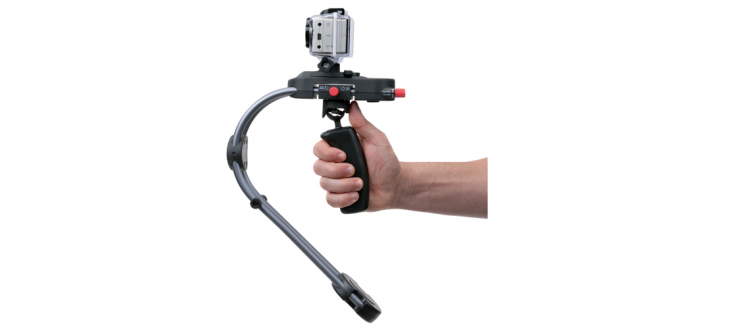
Here again, the first step is to make sure everything is balanced; this time, you use two little red knobs to tweak the rig’s center of gravity. Also here again, the pendulum effect both helps you—by stabilizing the phone or camera—and hurts you, by swinging as you move. And finally here again, you’re supposed to keep additional fingers on it, to keep it from turning off the axis you want.
The footage is indeed much, much smoother than what you’d get handheld. Like many stabilizers, though, the Smoothee’s weak spot is quick pans. When you’re pointed in one direction—shooting a skateboarder just ahead of you, say—it’s a champ. But if you suddenly whip your hand to a different angle, you get a delayed reaction and an overcompensating swing.
Note, too, that you can’t hold the Smoothee upside-down, as you can the other products here. You can’t shoot those great dog’s-eye-view videos.
Incidentally, the gravity-based handheld stabilizer concept is available from copycat brands at much lower prices. I found these on Amazon:
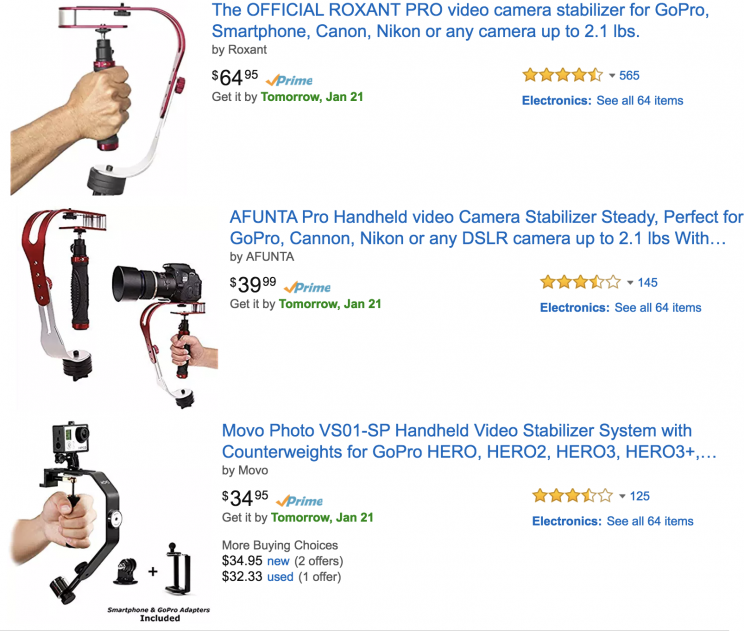
I haven’t tried them, but it’s likely they’ll offer the same pros and cons as the Smoothee.
GoPro Karma Grip
You may recall (or maybe not) that GoPro, the struggling sports-camera company, unveiled a drone last fall, the GoPro Karma. (Here’s my review.) One of its chief virtues was the stabilizer that held the GoPro itself—a stabilizer you could pull out of the drone and use handheld.
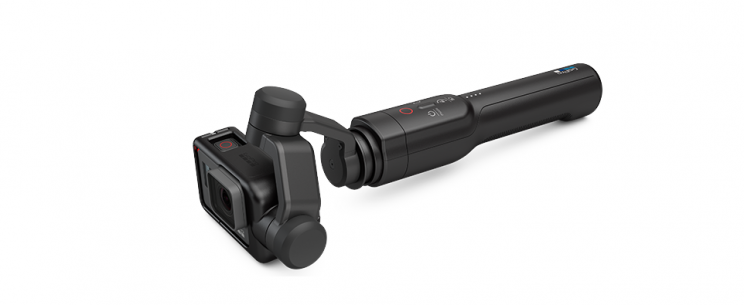
The Karma drone is a flawed product (and not just because it was recalled when a glitch caused some units to shut off in mid-flight). But the Grip, sold separately for $300 (GoPro not included), is a cool idea.
This is a motorized gimbal. You can move your hand all around, and the camera just sits locked in space, as though freed from the bonds of physics. It’s freaky in the way that a spinning toy gyroscope is freaky.
You have to charge it up before you use it; fortunately, the Grip also charges the GoPro attached to it.
The stabilization is unbelievable. It’s miles better than the gravity-based steadiers. In fact, no other product touched the fluidity of the chase shot it produced in my tests (see the video above); I mean, it looked exactly like a Hollywood movie shot. I tried it again, holding the Grip upside-down, with the camera down by my feet. Once again: GORGEOUS, smooth, floating video.
Since it’s just a handle, something like a flashlight, you can also stuff it into your jacket or backpack strap, point it forward, and let it film your skateboard, skiing, or mountain-biking run. You will be so happy with the results.
On the other hand, the Karma Grip has a couple of forehead-slapping drawbacks. First, it can’t hold a phone; the only thing you can put on it is a GoPro Hero 4 or 5 (be sure you buy the correct version).
Second, the gimbal mechanism spends most of its time blocking the Hero’s screen—and covering up one of its microphones. Oops.
DJI Osmo Mobile
DJI is another drone company that has branched out into stabilization products. The Osmo Mobile ($300) is another motorized gimbal, but this time, your smartphone is the camera. (It’s a spinoff of the regular Osmo, a much more expensive device that has a built-in camera.)
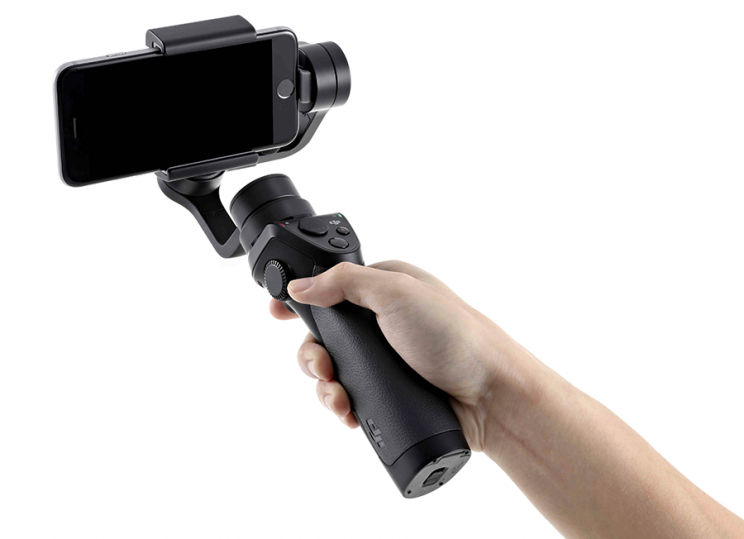
Here again, the results are astonishing. You just can’t believe this video came from your phone. It looks like it was shot from a helicopter or a camera on a dolly (“train tracks”).
But it gets better—much better. There’s a four-way sliding button on this handle that motorizes the pans (side-to-side) and tilts (up-and-down) of your camera. The Osmo not only stabilizes your phone, but it also motorizes its movements, smoothly and gracefully. Between your own arm’s motion and this button, you can create spectacular, cinematic moves—either at arm height or, held upside-down, way down low.
The grip has dedicated shutter buttons for video and still photos, too. On the far side, there’s a trigger; hold it in with your index finger to make the camera lock its gaze. Now you can raise or lower your arm; the camera tilts to stay focused on the subject.
You can use your phone’s regular camera app. But if you download DJI’s companion video-capture app, you get some bonus features. One of them lets you draw a box around your subject—and then as you move (or it moves), the Osmo automatically tilts and pans the phone to keep the subject in the frame. So cool.
Another app feature is designed for time-lapse video: It stretches out a pan or a tilt over a very long time.
SteadiCam Volt
The whole stabilizer field is about to get a jolt with the Volt, which is SteadiCam’s motorized consumer stabilizer. If it were a movie, it would be called “Volt: SteadiCam’s Revenge.”
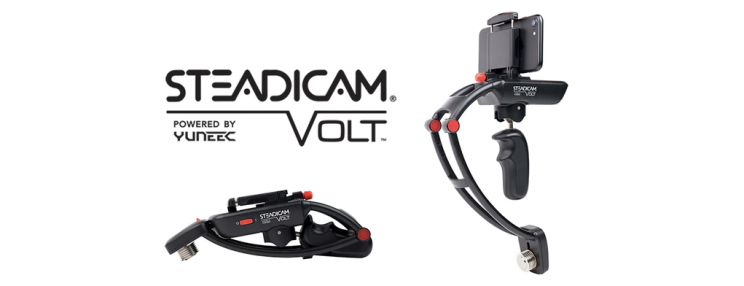
It’s only a Kickstarter prototype right now (although one that’s already shot way past its goal), so I haven’t tested it. But once it’s a shipping product, it will offer two killer advantages.
First, its price will be $200, not $300. Second, the company says that it doesn’t lag when you do quick turns—like sudden pans or tilts—the way the Karma Grip and even the DJI Osmo Mobile do. If you want to do a whip pan, do a whip pan. (The Kickstarter video shows this feature in action.)
Of course, $300 or even $200 is a lot if all you ever film is your toddler’s waddles or your roommate’s antics. But it’s next to nothing compared with the $50,000 SteadiCam rig whose steadiness these motorized handles resemble. If you’re aspiring to be a YouTube celebrity, journalist, extreme sportster, or budget filmmaker, a stabilizer could be a powerful way to upgrade your work without changing cameras.
And you know what? Even one of the cheapies works better than your hand.
David Pogue, tech columnist for Yahoo Finance, welcomes non-toxic comments in the Comments below. On the Web, he’s davidpogue.com. On Twitter, he’s @pogue. On email, he’s poguester@yahoo.com. You can read all his articles here (http://finance.yahoo.com/news/david-pogue/), or you can sign up to get his columns by email (http://j.mp/P4Qgnh).

